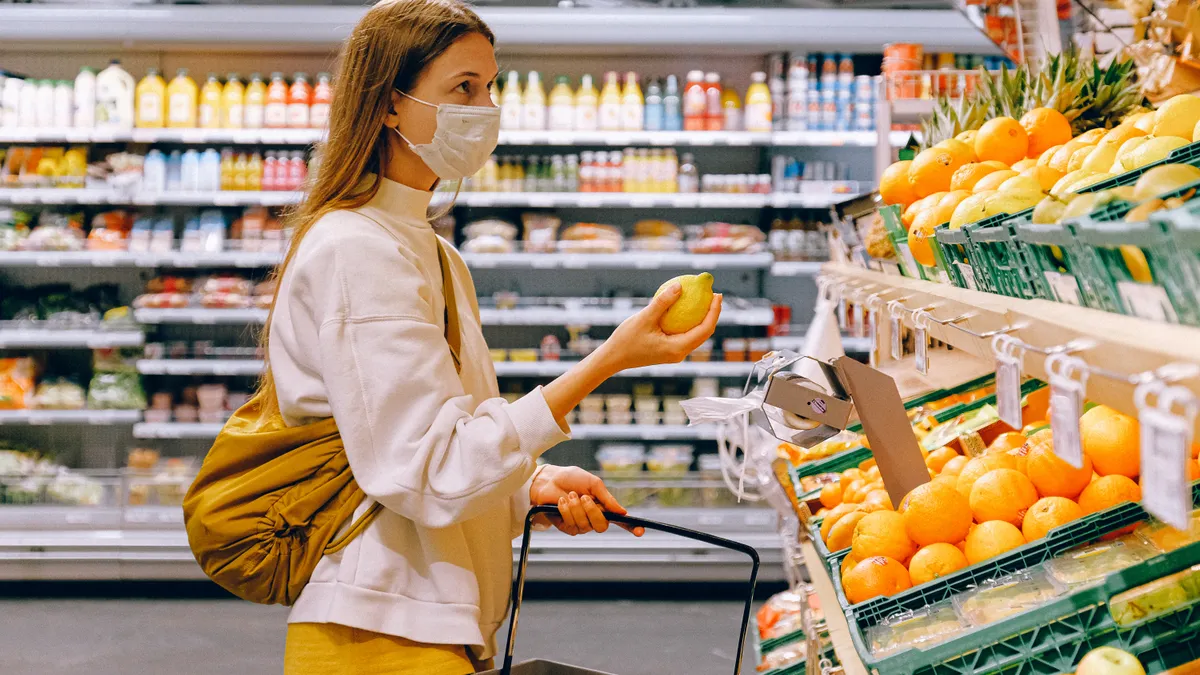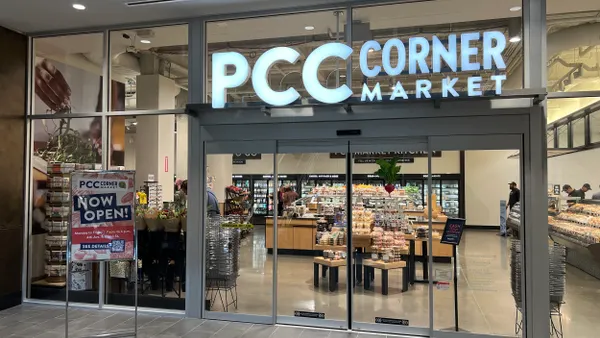Meat and fresh seafood along with meals and baking aisles are seeing booming sales as the coronavirus pandemic upends the grocery industry.
Using data collected by marketing research firm 210 Analytics and IRI, Grocery Dive examined sales across 11 categories at multiple outlets, including grocery, dollar and mass merchandisers.
To see how the categories performed during the pandemic, Grocery Dive looked at the percentage growth of dollar sales from March 15 to Oct. 4 of this year compared to the same time period last year. For comparison, the same categories saw sales increase between 0.4% (dairy) and 4.2% (deli) year-over-year in 2019.
Here's a look at those sales followed by a deep dive into some of the top findings.

Floral and deli dipped
Deli and floral were the two categories that lagged during the pandemic while all other major categories far outpaced their calendar year 2019 sales growth in just seven months.
Floral was the only category that saw negative sales growth during the measured period (-0.6%) as canceled, postponed and downsized events like weddings cut into sales. Floral producers and sellers have said sales have ebbed and flowed around holidays during the pandemic.
Meanwhile, the deli department has seen wildly different sales depending on the section. Meat, cheese and prepared foods in the deli department saw similar sales growth year-over-year in 2019, ranging from less than 1% to just over 2%. During the pandemic, however, deli meat and cheese saw sales increase 11% and 15%, respectively, compared to the same time period last year. But those gains were nearly erased by the closure of soup and salad bars, causing the prepared section to decline more than 23%.
While some grocers still have those self-serve bars closed down, others have brought them back, filled with pre-packaged items or repurposed them. “Better integration of deli prepared offerings with apps and websites for online ordering, outside pickup, delivery or drive through would be ways to resolve this,” Anne-Marie Roerink, president of 210 Analytics, wrote in an email.
Meat and seafood boomed
The fresh seafood (32%), frozen food (30%) and the meat department (28%) saw some of the largest sales growth during the measured period, with IRI and 210 Analytics predicting that by the end of the year sales will hit roughly $55 billion for the meat department, $49 billion for the frozen department and $5 billion for fresh seafood.
Sales have stayed elevated throughout the pandemic so far this year as more people prepare meals at home. Meat and seafood led perimeter growth in Q2 with sales up roughly 32% from 2019, according to the United Fresh Produce Association. A recent study by the Food Industry Association and the Foundation for Meat and Poultry Research and Education, which was prepared by 210 Analytics, found that roughly 48% of surveyed shoppers bought more meat during the first half of the year.
Still, grocers have struggled during the pandemic with reports of workers getting sick, prompting meat processing facilities to shut down and grocers to place purchasing restrictions on certain items.
Plant-based meat sales are growing much faster than conventional counterparts, but they still have a long way to go to catch up to the $95 billion U.S. meat market at retail.
Thanks in part to meat shortages, grocery stores saw fresh seafood become one of the fastest-growing categories over the last few months. Restaurants saddled with coronavirus restrictions have also freed up supplies of seafood and meat that consumers would expect to find at those establishments.
Meanwhile, stocking up on frozen food makes sense for shoppers looking to cut down their number of shopping trips and to solve meal planning and preparation fatigue as the pandemic continues.
Grocery aisles rebound
At roughly 20%, sales for the center store, which includes food and beverage, but excludes fresh foods, like produce, meat, seafood, bakery and deli, increased — a stark contrast to the challenges grocers have faced with the center as shoppers in recent years turned to the perimeter. store. Center store had previously seen sales slow in recent years. Meanwhile, under the general food aisles, baking supplies show the most growth (38%), followed by meals (34%) and breakfast items (17%).
Candy aisle sales bumped up nearly 3% year-over-year in 2019, but that growth hasn’t been as sweet during the pandemic, with sales only up half of a percent between March and October.
Dairy for all occasions
Roerink noted dairy has been a "powerhouse" department during the pandemic thanks to its utility and versatility. Cheese has been popular due to its ability to fit into numerous meals and eating occasions, she said, while milk, butter and eggs have all benefited from the rise in home cooking. Coffee creamer has also been a standout category due to more people having their "Starbucks moment" at home, Roerink said.
"We still see creamers trend far above last year’s levels, so people are still playing barista at home," she noted.
Prior to the pandemic, industry executives expressed concern about a lack of promotions around nutritional benefits and sustainability efforts as dairy consumption grew. Over several years, demand has been declining as dairy is disrupted by milk alternatives and private label products pouring into the category. Among the food and beverage categories Food Dive recently examined using Nielsen data, oat milk was among the top five products that saw the biggest dollar sales increase (212%) in a 31-week period ending Oct. 3 of this year.
Bakery was a mixed bag
Fresh and packaged bakery items have continued to grow and are collectively up almost 9% during the pandemic period. But while in-store bakery sales have powered growth in recent years, including last year, the bakery aisle has taken over this year, with 14% dollar growth in that category occurring between March and October. In-story bakery sales dropped 8% during the period.
Roerink said the drop in in-store bakery sales is due to safety concerns around loose items as well as the drop in events like birthday parties and weddings that drive cake sales. To reduce the risk of spreading the novel coronavirus, grocers pivoted to individually packaging baked items instead of leaving them out in the open or in cases shoppers would grab items from.












